Delve into the lively festivities of Ganesh Chaturthi. Enjoy the rich traditions, colourful decorations, and communal spirit that make this festival a truly magical experience.
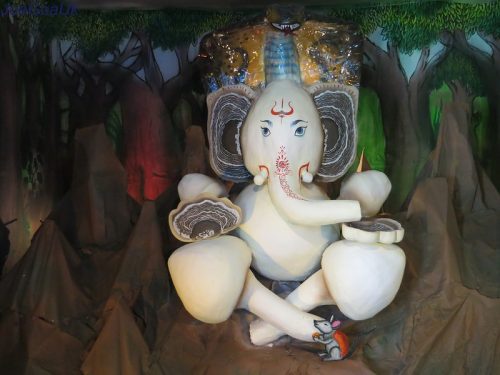
Ganesh Chaturthi, also known as Vinayaka Chavithi, is a cherished Hindu festival celebrated annually over 10 days. This vibrant festival typically takes place in the Bhadra month of the Hindu calendar, usually between mid-August and September, and marks the birth of Lord Ganesha, the beloved elephant-headed deity.
Lord Ganesha is revered as the God of wealth, knowledge, wisdom, and prosperity, which is why Hindus often invoke his blessings before embarking on any significant endeavour. Devotees believe that praying to Ganesha removes obstacles and brings success, making his worship an integral part of many Hindu rituals. Over the years, the celebration of Ganesh Chaturthi has grown in scale and enthusiasm, becoming a festival filled with joy, devotion, and cultural significance.
This vibrant and deeply significant festival celebrated across India, is dedicated to Lord Ganesha, the elephant-headed deity known as the remover of obstacles and the god of wisdom and prosperity. The festival marks the birth of Ganesha, a beloved figure in Hindu mythology, symbolizing new beginnings and auspiciousness.
The significance of Ganesh Chaturthi extends beyond religious observance; it embodies themes of renewal and community. The festival begins with the installation of Ganesha idols in homes and public spaces, followed by days of worship, chanting, and offerings. Devotees believe that Ganesha’s presence brings good fortune, success, and the resolution of personal and collective challenges.
One of the festival’s key elements is the immersion procession, where the Ganesha idols are taken through the streets in grand parades before being submerged in water. This ritual symbolizes the cycle of creation and dissolution, reminding participants of the impermanence of life and the importance of letting go. The vibrant celebrations foster community spirit, bringing people together in a shared expression of devotion, joy, and cultural heritage.
Ganesh Chaturthi, thus, serves as a profound reminder of the power of faith and the potential for transformation and unity in the face of life’s obstacles.
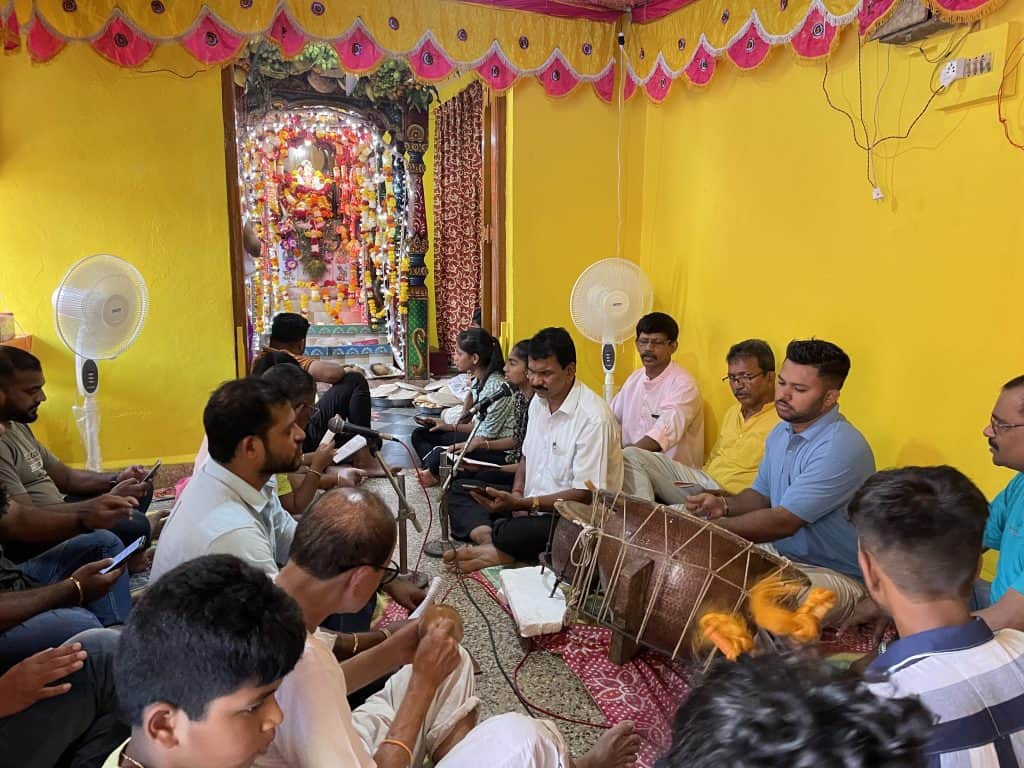
As the calendar flips to the most awaited month of the year, the excitement is palpable, with the Ganesh Chaturthi festival approaching. The markets are abuzz with vibrant stalls selling intricately crafted Ganesha idols, colourful makhars, and an assortment of traditional Chaturthi snacks, filling the air with an atmosphere of festivity and devotion.
Ganesh Chaturthi being an integral part of Goa’s cultural heritage serves as a unifying force for family reunions and social gatherings. Unlike other parts of India, Goa’s celebrations are deeply rooted in tradition and community values, reflecting the state’s unique cultural roots.
The tradition of Ganesh Idols and colourful Rangoli
Artisans are busy crafting exquisite idols of Lord Ganesha, meticulously shaping and moulding clay and eco-friendly materials into intricate masterpieces. The idols, ranging from small to life-sized, are then painstakingly hand-painted and adorned with vibrant hues and delicate patterns infusing them with a divine aura.
The preparation begins well in advance, with families decorating their homes with intricate designs, colourful rangoli, and vibrant decorations, creating a festive atmosphere that permeates every corner of the state. The markets are also abuzz with vendors showcasing a vast assortment of Ganesh Chaturthi essentials.
Matoli Tradition
Matoli is a crucial part of traditional decorations, featuring an intricately crafted canopy of local plants, fruits, and herbs carefully arranged above Lord Ganesha’s idol. This vibrant display boasts an astonishing array of over 100 items, including a mix of wild and cultivated produce, many with medicinal properties.
Classic matoli arrangements typically include an assortment of essentials like betel nuts, coconuts, and an array of wild and local produce Citrus fruits like Toring and Mauling (a local citrus fruit), a local variety of cucumbers and melons like Chibud, wild inedible fruits like Kanglam, ghagre and Kundalam, wildflowers like harne and a collection of leaves called gavar alongside fruits like guavas, apples, and bananas as well as chitpam, a wild fruit.
The tradition of making Modak and other Treats for the Taste Buds
Goans traditionally enjoy a variety of sweet and savoury treats served as prasad during the Ganesh Chaturthi festival, which includes modak (a favourite of lord Ganesha) nevryo which are either sweet made of gram flour which contains the filling of semolina, desiccated coconut, dry fruits and sugar or spicy along with other sweets like gram flour and semolina ladoo, coconut barfi, chakli, shankarpali, and chivda.
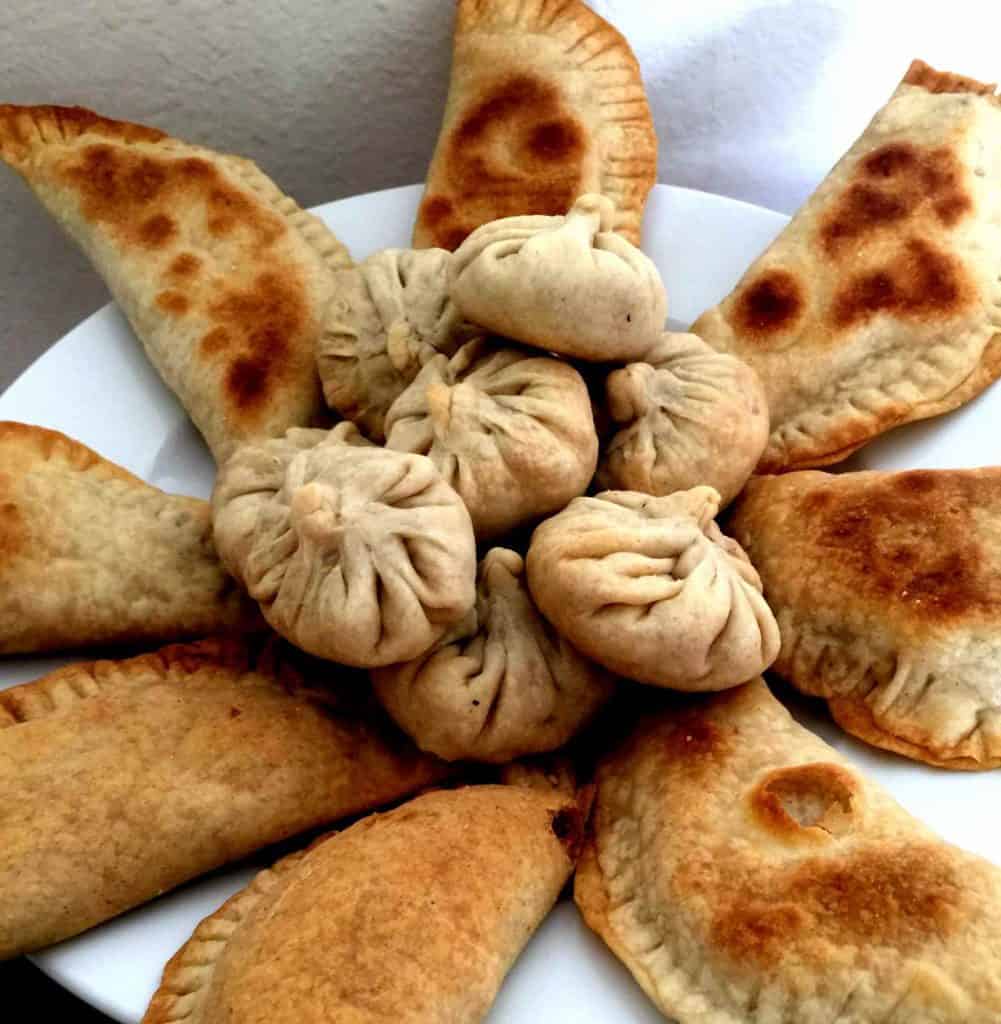
The traditional Modak, typically made in steamed (ukdiche), panchakhadya, and puran, has undergone a modern transformation with the introduction of chocolate Modak.
Traditional fugdi and aarti performance
During Chaturthi traditional folk dances like fugdi, bhajan, aartis bring vibrant energy to the festivities. Aartis are performed by singing hymns and waving diyas around Lord Ganesha’s idol, creating a captivating display. The Younger generations also perform ghumat aartis. Meanwhile, Fugdi brings all the ladies together who perform a lively traditional dance, singing traditional songs and dancing with abandon, characterized by quick footwork and radiant smiles. Bhajans are also performed during chaturthi.
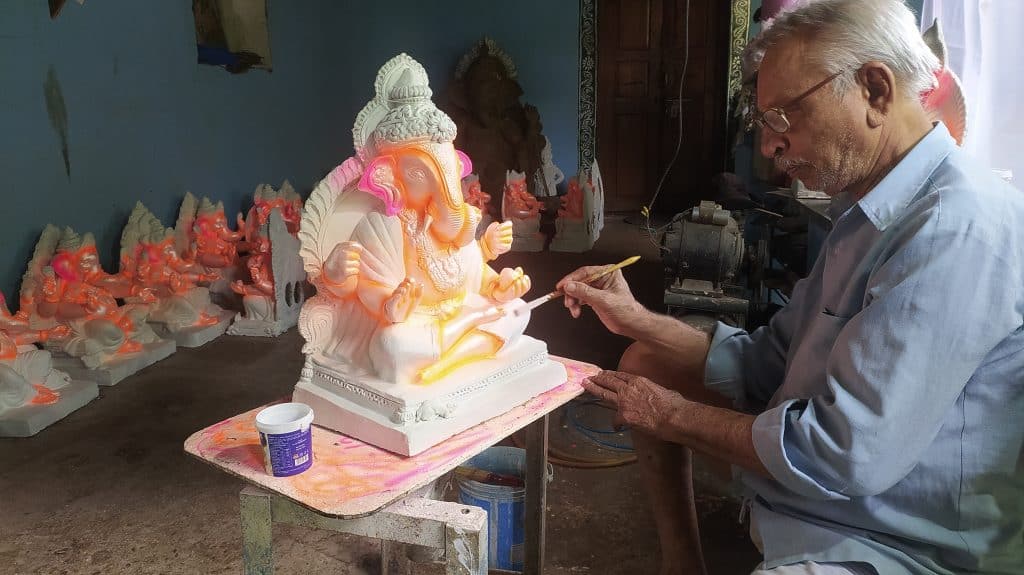
Dekhava Tradition
In Marcel and Cumbharjua, the ‘Dekhava’ tradition takes centre stage, featuring a spirited showcase among families and groups to craft the most captivating displays. The streets are resplendent with vibrant lights and decorations, while the air resonates with soulful devotional songs.
The tradition of creating intricate ‘dekhavas’ has been cherished and passed down for hundreds of years. Many homes feature wooden lofts, offering the perfect space to craft these detailed displays. Far more than simple decorations, dekhavas are a creative expression of each household’s unique vision, with every family selecting a different theme each year.
Over the years, the dekhavas vividly bring to life different scenes from a variety of mythological stories. One scene portrays Vasudev carrying the newborn Krishna in a basket across the River Yamuna, with a protective hooded snake shielding the baby from the rain. Another tableau features Panduranga accompanying Janabai as she grinds jowar, while yet another captures the dramatic moment when Krishna beheads Kamsa. Each display not only showcases the remarkable creativity of local homes but also reflects their deep connection to their cultural heritage.
Sangod Tradition
Cumbharjua village is also known for its unique “Sangod” tradition, where the vibrant Ganesh visarjan procession held on the 7th day of Ganesh chaturthi is done with decorated canoes and boats. These floats showcase mythological scenes as well as contemporary social messages.
The festive spirit comes alive as locals celebrate by decorating Sangods—canoes tied together and transformed into vibrant floating stages. Villagers dress up as mythological characters, adding a lively and colourful touch to the celebrations. For seven days, the Ganesh idol is worshipped at the temple twice daily, with the final day marking a grand culmination. After the evening aarti, the idol is carried out on a palki, accompanied by the rhythmic beats of a ghumot drum. It is then placed onto a Sangod, (canoe) which takes seven ceremonial rounds around the canal before the final immersion.
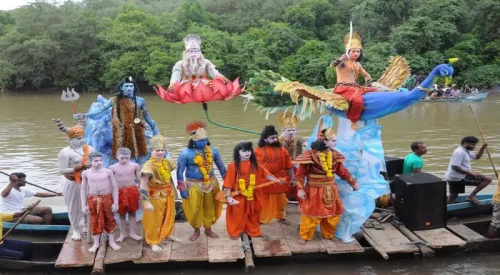
This age-old tradition has spread to many other villages, enhancing the festive atmosphere and bringing more people together each year. The Cambarjua canal now sees several Sangods, beautifully adorned with vibrant colours, flowers, and garlands, as part of this time-honoured celebration. The creative artistry involved in making these Sangods has even inspired local authorities to host competitions, encouraging broader participation and keeping the tradition alive and thriving.
Regenerative and Spiritual Tourism
Ganesh Chaturthi celebrations in Goa embody the essence of regenerative and spiritual tourism, offering a profound experience that nourishes both the soul and the local community. The festival reinforces the bonds of kinship and friendship, and the community comes together to celebrate with great fervour and devotion.
A Celebration of Unity
The varying durations of the festival allow for diverse expressions of devotion and community involvement, making each celebration unique yet deeply connected to the collective spirit.
Ganesh Chaturthi is a festival that embodies the spirit of devotion, community, and celebration. The streets will soon be filled with the sweet scent of modaks, the sound of devotional songs, and the vibrant colours of decorations. Get ready to immerse yourself in the joyous spirit of Ganesh Chaturthi, a celebration that brings people together in a shared tribute to the beloved Lord Ganesha.
FAQs About Modak and Ganesh Chaturthi
- What is a modak? Modak is a traditional Maharashtrian sweet that is especially popular during Ganesh Chaturthi. It is a steamed dumpling made from rice flour or wheat flour, filled with a mixture of grated coconut, jaggery, and cardamom. The combination of a soft outer shell and a sweet, flavorful filling makes modak a beloved treat for people of all ages.
- Why is modak associated with Ganesh Chaturthi? Modak holds a special place in the rituals of Ganesh Chaturthi as it is believed to be Lord Ganesha’s favorite sweet. It is customary to offer 21 modaks to Lord Ganesha during the puja, as the number 21 symbolizes the completeness and totality of offerings to the gods. This tradition is thought to bring blessings and prosperity to devotees.
- What other sweets are prepared during Ganesh Chaturthi? While modaks are the most popular offering during Ganesh Chaturthi, other sweets such as laddoos and barfis are also commonly prepared. These sweets are shared among family and friends as part of the festive celebrations.
- How did modak become Lord Ganesha’s favourite sweet? According to Hindu mythology, modak became Lord Ganesha’s favourite sweet due to a story involving his maternal grandmother, Queen Menavati. As the tale goes, Queen Menavati would often send laddoos to Ganesha at Mount Kailash. One day, when Goddess Parvati found that there were no laddoos left, she quickly created a new kind of sweet—modak. Ganesha loved the modaks, and they soon became his favourite treat.
- What is the significance of offering 21 modaks during Ganesh Chaturthi? The offering of 21 modaks to Lord Ganesha during Ganesh Chaturthi is symbolic of completeness and the totality of offerings to the gods. This number is considered auspicious and is believed to please Lord Ganesha, bringing blessings and good fortune to the devotees.
- What are the many names of Lord Ganesha? Lord Ganesh is known by 108 names. Here are some of the most revered names of Lord Ganesha: Dhoomraketu, Sumukha, Ekadantha, Gajakarnaka, Lambodara, Vignaraja, Ganadhyaksha, Phalachandra, Gajanana, Vinayaka, Vakratunda, Siddhivinayaka, Surpakarna, Heramba, Skandapurvaja, Kapila, and Vigneshwara. He is also widely known as Maha-Ganapathi.
Read more: Latest



